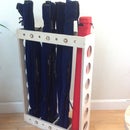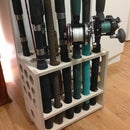Introduction: Burl Veneer End Table Made With CNC Router and Vacuum Bag System
Here is an end table built from shop grade 3/4 inch plywood. All of the surfaces are covered with veneer. I used a combination of eucalyptus burl and primavera solid veneers for this project.
This project was a test of my vacuum pump and bagging system that I had just built.
Step 1: Materials and Tools
Materials
3/4 inch plywood - less than a quarter sheet
veneer for top - 24 X14 inches
veneer for legs- 22 x10 inches
wood glue
veneer glue
cold press veneer glue
veneer softener
220 and 300 grit sandpaper
varnish
Tools
CNC router
Laser cutter
vacuum pump
vacuum bag
sander
Software
Autodesk Inventor
Vetric VCarve
Step 2: Design
I made the design on a 3d modeling program, but this design could have been easily accomplished with any 2d vector drawing program. The design is imported into a CAD program for the vector cuts.
The legs are attached to the top via a blind mortise. In other words, there is a pocket cut into the bottom of the table for each leg. The pocket fit should be tight, as the legs are attached with glue only. I designed for the smallest router bit I had (1/8) to cut the dog-ears in the pocket to maximize the surface area available for gluing.
Note that the legs are Shaker style, with a curve only on the inside.
Step 3: Attach Surface Veneers to Plywood
The suggested method for this type of construction (using solid veneer for edge banding) is to first cut out the parts, then apply the edge banding, and finally apply the surface veneers. Gluing the edge band with contact adhesive or heat -locking glue can leave a thick glue line, so having the surface cover the edge band allows the glue line to be hidden.
I decided to try gluing the surface veneers prior to cutting, and later applying the edge band under vacuum to avoid the glue line issue. This worked for the legs, but not as well for the table surface.
1. Apply the veneer softener of choice, and clamp /weight until dry (about 24 hours). This step can be skipped if the veneers are relatively flat.
2. A layer of cold press veneer glue is applied to the plywood (about the thickness of a coat of house paint.
3. The plywood is placed in the vacuum bag and held under ~20 Hg vacuum until the glue sets (about 45 minutes for the glue I used).
4. Wait 24 hours.
5. The veneers are sanded flat and a single layer of varnish is added. This minimizes tear-out when cutting the parts on the router.
Step 4: Cut on CNC Router
I cut the piece veneer side down using a 1/4 downcut bit first, then finished the last 1/8 inch with a 1/4 upcut bit. The dog-ears in the leg pockets were cut with a 1/8 downcut bit. The photo shows the dogears being cut.
The pockets are 1/2 inch deep.
Step 5: Edge-band
1. Apply veneer softener and press flat according to the product directions,. This is necessary to allow the edge band to cut cleanly and be glued to a curved surface without splitting.
2. Cut the strips for the edge bands very slightly larger than the thickness of the part. I used a laser cutter. a veneer saw can be used as well
3. Glue and press in vacuum bag. Use painter's tape to hold the edge bands in place. You will need to support and position the part so that the bag surface will wrap around the edge band. This worked well for the legs, but left some gaps in the tabletop edge where the curve met the straight edge. I was able to adequately repair this with some glue, clamps, and foul language.
UPDATE: I now do my edge band attachment by applying wood glue to both surfaces separately, letting the glue dry and using the same iron on method used with pre-glued edge banding. The heat from the iron temporarily reactivates the glue. For some glues, there is a limited time window where this works. I use TiteBond III. According to the following link, I have a twelve hour window:
http://www.webherrera.com/blog/2009/04/19/titebond..
This method has worked well for me so far.
Step 6: Assemble and Finish
1. Sand the parts.
2. Glue the legs to the top. If the fit is tight, no clamping is needed. Double check that the legs are square and that the table sets evenly on the floor before the glue dries. Wait for the glue to dry completely.
3. touch-up sand any scratches and apply the finish of choice.
That's it!
Step 7: Retrospective
1 Design-wise, the table could be a bit more stable, but it is more stable than several other commercial products I later checked.
2. The vacuum veneer system works very well. A set of test cuts through a practice part revealed a uniform tight bond. The surfaces sanded flat easily.
3. Solid veneers require more work than pre-veneered plywood or paper-backed veneer, but provide many more choices of woods. Solid veneers are typically thicker as well, so a piece can be sanded and refinished in the future, extending its life.
4. The main difficulty with solid veneer is applying the solid veneer edge banding to large curved parts. In the future, I will try cutting some jigs and clamping, or as a lest resort- do it the proper way of edge banding first with heat lock glue or contact cement, as is done by the professionals. [UPDATE: I now use PVAC glue (brand TiteBond III) applied separately to edge banding and edges, and then iron on after drying. Easy-peasy. See "Edge Band" step for more details.]













